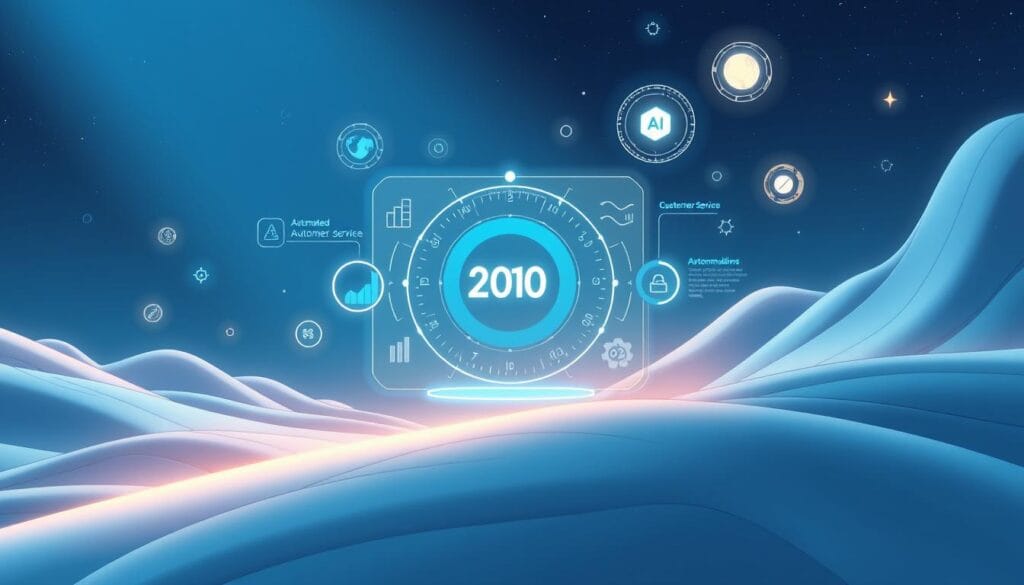
I remember when our customer service team was overwhelmed with support tickets. They faced endless questions, long waits, and unhappy customers. That’s when we found customer experience automation (CXA).
Automation is changing how companies talk to their customers. With new technologies, businesses can offer quick, personal support. This changes the whole customer experience. CXA isn’t just about replacing people—it’s about making them better at their jobs.
Think about cutting down wait times, making customers happier, and letting your team solve tough problems. That’s what CXA can do. It uses AI and smart systems to change how we connect with customers.
Key Takeaways
- Customer experience automation streamlines support processes
- Technology enables personalized and efficient customer interactions
- Automation reduces operational costs and improves response times
- AI and machine learning are transforming customer service strategies
- Businesses can focus on complex customer needs through intelligent automation
Understanding Customer Experience Automation (CXA)

Customer experience automation changes how we handle customer interactions. Businesses aim to meet high customer expectations. They use intelligent automation to offer top-notch service.
Components of Modern CXA
Modern CXA uses advanced technologies. Conversational AI is key for smooth interactions. It uses machine learning to quickly and accurately meet customer needs.
Evolution of Customer Experience Technology
The customer experience tech world has changed a lot. From simple automated systems, we now have advanced platforms. These can predict what customers want, personalize interactions, and solve complex issues with great accuracy.
Key Drivers Behind CXA Adoption
Several reasons push businesses to use CXA. Strategic automation helps companies:
- Lower costs
- Offer 24/7 support
- Boost customer happiness
By using AI and machine learning, businesses can improve a lot. They can balance tech efficiency with human touch.
With AI and machine learning, companies can offer better, more personal experiences. This meets the high expectations of today’s customers.
The Impact of Customer Service Automation on Business Growth

Customer service automation is changing how businesses talk to their customers. It uses new technologies to improve support and help companies grow. For example, 90% of people want quick service, and automation can give it to them.
Using customer service automation brings big benefits. AI can talk to thousands of customers at once, making things run smoother. Companies can cut costs by 40% and make customers happier by 20%.
Automated support offers key benefits:
- 24/7 customer support availability
- Faster issue resolution
- Reduced operational costs
- Enhanced customer engagement
By using automation, businesses can free up people to focus on new ideas and solving tough problems. This way, teams can work better, up to 94% more efficiently, adding value for everyone.
Automation isn’t just about efficiency—it’s about creating more meaningful customer interactions.
The lasting effects of customer service automation go beyond saving money. Customers who get their problems solved fast are almost 2x as likely to buy again. This shows how important automated support is for keeping customers loyal.
Essential Technologies Powering CXA Solutions
Customer experience automation uses the latest technologies to change how businesses talk to customers. The digital world is always getting better, making systems that can really get what customers need. They can even predict and answer those needs with great accuracy.
Today’s customer service tools use advanced tech to change how we talk to customers. AI and machine learning lead this change. They let systems learn and get better over time.
Artificial Intelligence and Machine Learning
AI can make agents work 50% faster. Virtual assistants and chatbots use smart learning to get what customers mean. They look at lots of data to give customers what they want and need before they ask.
Natural Language Processing
Natural language processing makes chatbots and virtual assistants talk like people. They can understand the subtleties of human language. This means they can answer customer questions very well, making interactions feel real.
Advanced Analytics Platforms
Analytics platforms turn customer data into useful information. Tools like Kapture CX use AI to watch customer interactions in real time. They help businesses see what customers do, improve support, and make services better.
AI and GenAI are reshaping customer service by automating routine tasks and enabling more personalized, efficient interactions.
Building an Effective Customer Experience Automation Strategy
Creating a strong customer experience automation strategy needs careful planning. It’s about finding the right balance between technology and what customers really need. The goal is to make automation better, not replace, human touch.
When making a strategy, focus on tasks that really matter. Studies show 48% of customer service errors come from repetitive tasks. Automating these can make support better and faster.
Choosing the right tools is key. I tell companies to look at:
- How it fits with their goals
- If it can grow with them
- If it works with what they already use
- If it supports many languages
| Automation Strategy Component | Key Considerations |
|---|---|
| Technology Selection | AI-powered tools, CRM integration |
| Omnichannel Support | Consistent experience across platforms |
| Performance Metrics | Customer satisfaction, response time |
Offering support across all channels is vital. With 75% of people wanting help in their own language, automation helps a lot. McKinsey found companies could see a 40% return on investment by using automation wisely.
It’s important to train teams to work with automation. Keep improving and listening to feedback to keep your strategy sharp and effective.
Implementing AI-Powered Customer Support Solutions
Customer support is changing fast thanks to intelligent automation. Today’s businesses use self-service tools and AI to give great customer experiences. AI solutions are a key strategy for improving support operations.
AI can handle up to 80% of customer service tasks, easing the load on human agents. For example, Unity saved $1.3 million by deflecting 8,000 support tickets with AI.
Chatbots and Virtual Assistants
Virtual assistants are a big step forward in customer support. They offer 24/7 help on many channels like SMS and email. Zendesk AI, for example, uses billions of customer interactions to solve problems quickly.
Automated Response Systems
Automated systems use smart algorithms for personalized support. They analyze conversations to find trends and offer solutions. They work with CRM systems to improve customer interactions.
Self-Service Portals
Self-service tools let customers solve problems on their own. They offer quick access to help and guides. This approach boosts customer happiness and cuts support team work.
AI is transforming customer support from a cost center to a strategic asset for business growth.
Personalization Through Automation
Conversational AI has changed how businesses make customer experiences personal. It uses advanced data and smart algorithms. This lets brands create special paths for each customer based on what they like and do.
Personalization today is more than just suggesting products. Modern systems look at many data points to offer contextually relevant interactions. They know what customers want, guess their needs, and send content that really speaks to them.
| Personalization Strategy | Automation Impact |
|---|---|
| Dynamic Content Adaptation | 90% increased engagement rates |
| Behavioral Targeting | 75% improved conversion potential |
| Real-time Recommendation Engine | 65% enhanced customer satisfaction |
Personalization needs a careful touch. Automation can make experiences very personal, but businesses must respect privacy. The aim is to connect with customers in a way that feels natural and useful.
Personalization is about making customers feel understood, not just tracked.
Using smart conversational AI, companies can turn customer chats into personal experiences. This builds strong relationships and boosts engagement.
Measuring Success: Key Performance Metrics for CXA
It’s key to track the right metrics to see how well customer service automation works. By watching specific numbers, companies can make their automated support better. This leads to great customer experiences.
Customer service automation offers powerful tools for analyzing performance. I’ll explain the main metrics that show how well automated support works.
Customer Satisfaction Scores
Customer Satisfaction (CSAT) scores show if automated support meets user needs. These scores are from 1-5 and show how customers feel about automated support.
| Metric | Measurement Scale | Key Insights |
|---|---|---|
| Net Promoter Score (NPS) | 0-10 | Predicts customer loyalty and advocacy |
| Customer Effort Score (CES) | 1-7 | Evaluates interaction complexity |
| First Response Time (FRT) | Minutes | Measures speed of initial customer support |
Response Time Analytics
How fast automated support responds is very important. Quick responses show automated support is efficient. This makes customers happy. Tracking First Response Time (FRT) shows how well businesses do.
Cost Reduction Metrics
Using automated customer service is not just about better experiences. It’s also about saving money. Important cost-saving metrics include average handle time and cost per interaction. These numbers show the financial gains from using automated support.
Effective customer service automation makes customer interactions better while cutting down on costs.
Overcoming Common CXA Implementation Challenges
Starting customer service automation can be tough. Companies often find it hard to mix smart technology with the personal touch. Even with great tech, people still want real connections.
“Automation should enhance, not replace, human interaction.” – Customer Experience Expert
Keeping customer data safe is a big challenge. Companies must protect personal info while using new tech. Using strong passwords and safe cloud storage helps keep customers trusting.
Getting tech to work with what you already have is another big hurdle. You can automate half of customer questions. But linking it up with your CRM system is key. Poonawalla Fincorp showed how it can work, tripling conversions by answering leads faster.
Training your team is crucial for using new tech well. Hands-on training that mimics real situations helps staff get the hang of new tools.
The aim of customer service automation isn’t to replace people but to make them better. Using AI for routine tasks lets humans focus on what matters most. This way, customers get faster, better service.
Success in customer service automation comes from a balanced approach. It’s about using new tech wisely while keeping human touch. This way, you get both efficiency and real connection with customers.
Integration of Omnichannel Support Systems
Customer experience automation has changed how businesses handle support. Omnichannel support systems make it easy for customers to talk to companies on different platforms. This way, customers don’t lose their place or face any hiccups.
Companies that use strong omnichannel support see big wins. Studies show that those with integrated support keep 89% of their customers. These systems cut support costs by up to 30% and make customers 19% happier.
Omnichannel support’s main strength is giving customers the same experience everywhere. Whether it’s through email, social media, chat, or phone, customers don’t have to start over. This shows a big commitment to making customer service better.
Today’s businesses use smart tech to make support better. AI helps put all support efforts in one place, making things clearer and faster. For example, Spotnana has made things smoother by using all-in-one omnichannel solutions.
“Seamless customer interactions are no longer a luxury—they’re a necessity in today’s digital marketplace.”
Key benefits of omnichannel support include:
- Reduced ticket volumes
- Enhanced agent efficiency
- Improved customer satisfaction
- Comprehensive customer context tracking
By using omnichannel support systems, businesses can turn their customer service into a key advantage.
Future Trends in Customer Experience Automation
The world of customer experience is changing fast. This is thanks to smart automation and advanced AI. Businesses are finding new ways to connect with their customers. New trends are changing how companies offer top-notch service.
Emerging Technologies Transforming Customer Interactions
New tech is changing how we talk to customers. Augmented reality (AR) and the Internet of Things (IoT) are opening up new ways to support customers. By 2025, 65% of companies will use more AI in customer support, marking a big change.
Predicted Industry Changes
The call center AI market is expected to grow to $6 billion by 2032. This shows a huge growth area. Conversational AI will be key in changing how we talk to customers. Gartner says there will be $80 billion in savings by 2026.
| Technology Trend | Expected Impact |
|---|---|
| Multilingual AI Support | Instant translation and support across languages |
| Sentiment Analysis | Real-time emotional intelligence in customer interactions |
| Predictive Analytics | Anticipating customer needs before they arise |
Innovation Opportunities
Businesses can use smart automation to make customer experiences better and more personal. By investing in AI and focusing on customers, companies can turn customer service into a key advantage.
“The future of customer experience lies in seamless, intelligent interactions that anticipate and exceed customer expectations.” – AI Customer Experience Expert
As tech gets better, using AI and automation will be key for businesses to keep up in the digital world.
Conclusion
Customer experience automation is changing how businesses talk to their customers. By 2026, 85% of customer interactions will be automated. This shows a big change in how services are delivered.
Automation is not just a tech trend. It’s a must for businesses to stay ahead. They need to keep up with the times to compete.
Automation does more than just save time. AI can solve up to 80% of simple questions. It cuts wait times by 98% and makes customers happier.
Companies using these tools save money and handle fewer tickets. They see big improvements in customer satisfaction. This shows the power of automation.
Looking to the future, new tech like conversational AI and voice-activated support will change how we talk to customers. Businesses should invest in automation that also values human touch. The best companies will mix new tech with real human connection.
The path of customer experience automation is always moving. Businesses that adapt and focus on customer needs will grow. They’ll create better, more satisfying experiences that keep customers coming back.
FAQ
What is Customer Experience Automation (CXA)?
Customer Experience Automation uses advanced tech like AI and data analytics. It aims to make customer interactions better. This includes personalizing experiences and improving satisfaction.
How can automation improve customer service?
Automation offers 24/7 support and quick responses. It also lets customers solve problems on their own. This frees up human agents for more complex issues.
What technologies are used in Customer Experience Automation?
Key tech includes AI, machine learning, and chatbots. These tools help understand and answer customer questions. They also analyze data to improve experiences.
Is automation replacing human customer service representatives?
No, automation is meant to help, not replace, human agents. It handles simple tasks. This lets humans focus on more complex issues.
How can businesses measure the success of their CXA initiatives?
Success is measured by customer satisfaction and response times. Other metrics include first-contact resolution and cost savings. Improved retention is also key.
What are the challenges in implementing Customer Experience Automation?
Challenges include keeping a human touch and integrating with old systems. Data privacy and employee adoption are also concerns. Choosing the right tech is crucial.
How does personalization work in automated customer experiences?
Personalization uses data and AI to tailor experiences. It analyzes customer behavior and history. This way, customers get recommendations and support that fit their needs.
What is an omnichannel support approach?
Omnichannel support means consistent experiences across all touchpoints. This includes phone, email, and social media. It uses automation to ensure seamless interactions.
Are there privacy concerns with Customer Experience Automation?
Yes, privacy is a big concern. Businesses must protect data and be open about how it’s used. They must follow laws like GDPR and keep customer data safe.
What future trends are emerging in Customer Experience Automation?
Future trends include advanced AI and predictive analytics. Voice interactions and augmented reality are also on the horizon. These will lead to more natural and effective customer interactions.













